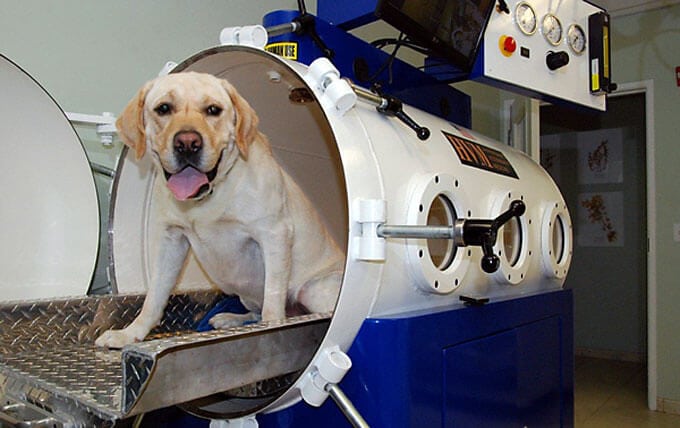What is Hyperbaric Oxygen Therapy?
Hyperbaric oxygen therapy, or HBOT, is a medical treatment in which pure oxygen is inhaled, in a total body chamber while atmospheric pressure is increased. The Food and Drug Administration (FDA) has approved hyperbaric oxygen therapy for treatment of 13 conditions, including stroke, burns, and carbon monoxide poisoning. These uses for HBOT are covered by insurance and recognized by the medical establishment.1
Recently, medical research (including several double blind studies) points to hyperbaric oxygen therapy as a coveted neuro-therapeutic method for brain repair, which may be good news for those suffering from autism, post traumatic stress disorder (PTSD), traumatic brain injury (TBI), cerebral palsy, multiple sclerosis, chronic fatigue syndrome, migraine headaches, metabolic disorders (which can lead to dementia and Alzheimer’s), as well as other neurological disease, impairment, or dysfunction.2 Despite such studies, the medical establishment seems to remain skeptical of the efficacy of HBOT in such “off label” uses. Due to overwhelming anecdotal evidence however, numerous doctors are beginning to see the efficacy of HBOT, and have begun to take it seriously, and give it a chance.
In a recent ESPN article on football, concussion, and TBI, Dr. Lee Fox of Jupiter Medical Center said that he wondered if HBOT could help the brain recover from long-term trauma. “A head injury is really just a wound of the brain,” according to Fox, “Why wouldn’t it work on a different type of wound?” Fox has eloquently summed up my personal view as well.
How Does Hyperbaric Oxygen Therapy Work?
HBOT is believed to jump start the body’s own healing processes by forcing oxygen deep into the tissues. During HBOT treatment the patient is placed in an enclosed pressurized environment while breathing 100% oxygen (ambient air contains 20% oxygen). The complementary components of this process (pressure and oxygen) transpire simultaneously, and work synergistically. The tissues are saturated with pure oxygen, and the pressurization of the chamber forces the oxygen deep into the tissue. This process pushes oxygen beyond the hemoglobin (red blood cells that carry oxygen) and into the blood plasma and interstitial fluid, (fluid between the cells)3 reaching tissue that has been traumatized and damaged by hypoxia.
Patients in medical grade chambers typically “dive” to 7.5 PSI (pounds per square inch) and 1.5 ATA (atmospheres absolute), for 60 minutes at the prescribed pressure, though more severe injuries may require a longer HBOT session, i.e., more time inhaling oxygen under pressure, and may require treatment at a greater ATA.
Types of Hyperbaric Oxygen Therapy Treatment Chambers
There are three types of chambers for Hyperbaric Oxygen Therapy treatment:

Free exclusive eBook, plus recipes and health tips, delivered to your inbox.
- Group chambers
- Individual chambers
- Home chambers
I have not witnessed HBOT treatment in a group chamber, but have heard it is highly effective.
As for individual hyperbaric chambers (which are also referred to as “hard” chambers) I’ve seen two types. The first looks like the cockpit of a tiny airplane. In this type of chamber the patient sits up. The second type of individual chamber is a bed enclosed in a hard acrylic bubble, this type allows the patient to lie down.
In either unit, the chamber is locked and sealed and then the patient is put under pressure. When the desired pressure is reached, the patient typically puts on a plastic hood and breathes 100% oxygen for one hour. After the hour, the chamber is brought back to normo-baric pressure (it typically takes about a minute per square inch). A patient would need around 9 minutes to get to a PSI of 9. It would also take 9 minutes to come back to normo-baric pressure from a PSI of 9.
HBOT home chambers look like tents and are referred to as “soft” chambers. They do not allow the patient to dive to the same depths as medical chambers and are therefore not thought to be as effective. Home chambers (which provide mild-hyperbarics) are legal in the US, though not in Canada.
Length of Hyperbaric Oxygen Therapy Treatment
Typical HBOT treatment may consist of 40 one hour sessions 5-6 days per week. By doing the treatments consecutively it is thought that new capillaries are forced to grow (this process is called angiogenesis) in tissues that may be oxygen starved, or suffering from hypoxia. Treatment is prescribed by a doctor and is customized to the individual’s condition. Some patients will receive a prescription for 80 treatments at sessions greater than one hour, and pressures higher than 1.5 ATA.
Cellular Improvement Observed from Hyperbaric Oxygen Therapy
As previously mentioned, during HBOT the body’s natural healing processes are activated when oxygen is pushed beyond the red blood cells and into blood plasma. Although no experts, nor studies that I reviewed, make the claim that HBOT can revive dead tissues, studies do indicate that damaged tissues can be revived by HBOT treatment.
Here are some of the observable cellular benefits of HBOT:4
- Increased tissue oxidation –more oxygen to the tissues
- Improved mitochondrial redox –the powerhouse of the cell loses an electron, similar to anti-oxidation
- Preservation of mitochondrial integrity –the powerhouse of the cell retains structure, avoiding damage
- Hindering of mitochondrial apoptotic pathways –prevents the mitochondria from dying prematurely
- Anti-inflammatory effects –reduce and or prevent inflammation in the cells and body
- Epigenetic effects –targeting of oxygen and pressure sensitive genes improves mitochondrial function
Conditions Treated by Hyperbaric Oxygen Therapy
As mentioned, double blind studies have shown the effectiveness of HBOT in treating victims of stroke, burn, and delayed wound healing. Other studies show improvements in a wide variety of quality of life issues; here is a comprehensive list of the conditions that HBOT can improve according to the medical literature:
- Stroke
- TBI5
- Severe Burns
- Diabetic Wounds
- Near Drowning
- Decompression Sickness
- Carbon Monoxide Poisoning
- Osteomyelitis6
- Severe Anemia7
Dr. Harch Leading Expert on Hyperbaric Oxygen Therapy
In 2010, Dr. Paul Harch wrote The Oxygen Revolution, the premier book on HBOT, a comprehensive and worthy read. Dr. Harch has published several studies on HBOT, and has a website with extensive medical information. According to Harch, “Hyperbaric oxygen therapy improves the quality of life of the patient in many areas when standard medicine is not working. Many conditions such as stroke, cerebral palsy, head injuries, and chronic fatigue have responded favorably to HBOT.”
Hyperbaric Oxygen Therapy and Military Veterans
A bill was introduced to congressional committee in January of 2015; if passed it would ensure access to HBOT at military medical facilities. There is significant anecdotal evidence that HBOT contributes to the healing of concussion and TBI.8, 9, 10
Hyperbaric Oxygen Therapy and Athletes
Olympic Swimmer Michael Phelps has used HBOT during his recovery, as has professional golfer Tiger Woods.11 In 2012, the Hall of Fame quarterback, Joe Namath, began HBOT. He had such great success, as documented in SPECT scans of his brain and cognitive testing, that he founded the Joe Namath Neurological Research Center in Jupiter Florida along with doctors Lee Fox and Barry Miskin, who plan to conduct a study testing the effects of HBOT on 100 people suffering from prolonged symptoms of brain injury.
Potential Side Effects of Hyperbaric Oxygen Therapy
Side effects of HBOT include potential build up of fluid in, and rupture of the middle ear, claustrophobia (individual chambers are tiny and locked), as well as myopia in certain rare cases; though doctors report that the retina returns to its normal shape and eyesight is restored within a few months of the conclusion of HBOT.12
History of Hyperbaric Oxygen Therapy
Apparently, the use of treatments akin to hyperbaric oxygen therapy date back a couple hundred years, with some anecdotes suggesting such treatments first began in the 17th century.
In the 1930’s the military developed and tested HBOT to treat deep sea divers with decompression sickness. Otherwise known as the “bends,” decompression sickness occurs when a scuba diver comes to the surface of a body of water too quickly, causing nitrogen to build up in the body, and dangerously so in the brain. The treatment for the bends is HBOT (increased pressure with 100% oxygen).
Animals and Hyperbaric Oxygen Therapy
As mentioned above, HBOT is an efficacious treatment for certain conditions suffered by humans; it is also a treatment used for animals. According to this paper from a veterinary journal:
Hyperbaric therapy utilizes several physiologic principles of how oxygen responds under pressure. The increase in concentration of oxygen in solution, based on its solubility under pressure, increases the diffusion gradient for its delivery deeper into tissues, which is the premise of HBOT. Ultimately the increases in dissolved oxygen generated by hyperbaric therapy have several physiologic effects that can alter tissue responses to disease and injury. As this technology becomes more available to clinical practice, HBOT should be considered as a therapeutic option [for animals].13
HBOT became a popular treatment for pets in the early 2000’s as an adjunct to traditional medical treatments. Before this a number of veterinarians had used hyperbaric therapy in small animal facilities. However, as HBOT gained popularity in the veterinary field, large animal hyperbaric chambers were developed and placed in many veterinary practices, rehabilitation facilities, and educational institutions in multiple countries. HBOT is now routinely used to treat swelling, trauma, non-healing wounds, and other ailments in animals including dogs, cats, ferrets, rabbits, and horses.14
Conclusion
Studies demonstrate that HBOT may assist in the healing of numerous conditions for which it is not currently approved by the FDA. Anecdotal evidence points to incredible results with HBOT for a variety of neurological conditions including autism, TBI, PTSD, and much more.
Whether or not you believe HBOT is an efficacious treatment or a scam, there is a lot to learn about it and the potential of this therapy is exciting for those of us with neurological issues that appear to be untreatable. What are your thoughts regarding HBOT? Leave a comment and let us know!






LAURA R RADELL says
I am currently using HBOT as a therapy to heal a wound from a botched surgery that wouldn’t heal. It has done wonders, and even though my insurance wouldn’t cover it, I haven’t regretted a penny I’ve spent. I am amazed at the healing that has occurred in 4 weeks!!
Elana says
Laura, it is AMAZING!
Jeff Carbine says
I’m glad that you talked about HBOT (hyperbaric oxygen therapy) as a medical treatment in which pure oxygen is breathed while atmospheric pressure is elevated in a complete body chamber. One of my parents’ friends needs to know this article because they are trying to find specific information about it in a couple of days. Thank you for the tips about hyperbaric.
Elana says
Jeff, you’re welcome!
AJ358 says
I have been using HBOT for my MS for 10 years! I’d love to know where you do yours as private clinics are hard to find.
Elana says
Rocky Mountain Hyperbaric Clinic just outside of Boulder, Colorado :-)
Rick says
Can I ask what is classified as an “air break”? Usually 5 minutes. Some of the studies reference them but it’s not clear to me.
Do they keep you in the chamber at high pressure and shut off the pure 02 or do they shut off the 02 AND decompress you for the 5 minutes – then put you back in?
Elana says
Rick, I “dive” at 1.5 so have not had to take breaks. I would guess that it’s a break from 100% 02 which has the potential to cause oxygen toxicity seizures in some people, but your best bet would be to check with an HBOT doctor.
Rick says
Hey Elana – seeing the communication in the chat – you do have something that says “7.5 ATA”. That caught my attention as well. Search for it in your article. You’ll find it.
Hope that helps.
Elana says
Rick, thanks for your comment! I’ve fixed this error :-)
Lori says
You have a line that states some patients receive up to 80 sessions at pressures higher than 7.5 ATA. This is totally false. No one that does HBOT, unless they are being treated by the Navy for severe decompression sickness, typically go about 2.8 ATA. You should get your facts straight before publishing a page about HBOT.
Elana says
Lori, thanks so much for your comment! If you read more closely you’ll see that I state, “Patients in medical grade chambers typically “dive” to 7.5 PSI (pounds per square inch) and 1.5 ATA (atmospheres absolute)” Please let me know if you have any other questions, happy to help :-)
Ben says
Hello I am thinking about buying a hyperbaric chamber as my dad has GBM4 and it has been recommended to us To help him, also I would use it for general everyday health. I found one that looks very good with only 125 hours on it and operates at 1.3 atm. Is it worth spending a bit more and getting one that can operate at 2 atm?
Thanks in advance.
Elana says
Ben, this sounds like a great question for a medical practitioner given that this is a medical treatment. I hope you’ll stop back by and LMK what you decide to get :-)
Edmond J Fitzpatrick says
I’m concerned that my individual Hbot for 120 min. at 2.5 ATA with two Air brakes
has been reduced to 1.5 ATA without any Air breaks as they ran out of Air (bottles)
waiting for delivery. At 1.5 ATA of pure 02 for two hours is ok as far as Concentration.
three days still no Air. Should I say something?
Elana says
Edmond, thanks for your comment. Where do you get treatment?
Paul Rusinko says
When are lower HBOT pressures effective vs high HBOT persures.
Elana says
Paul, thanks so much for your comment and question! Various pressures effect patients differently. Sometimes higher ATA will be used for more severe symptoms, but that is not always how it works, of course in this case I’m referring to medical grade chambers as soft shell chambers are not all the efficacious in treating neurological conditions.
Alex says
Hi, does it make a difference if the 40 sessions are delivered twice a day (5 days a week) for 4 weeks — as Dr. Harch seems to do — versus the 40 sessions delivered once a day (5 days a week) for 8 weeks that you mention?
Elana says
Alex, I would guess it would be different for each case since we’re all biochemical individuals doing HBOT for different reasons :-)
Mike says
It’s more important to do it vs being precise. Just get your sessions in twice a day morning and night I have found to make me feel better. While we are all different people and respond slightly different to treatments. I have found in the grand scheme of things we all respond in the same way. I think the medical community has “we are all unique” mostly wrong.
Elana says
Thanks Mike!